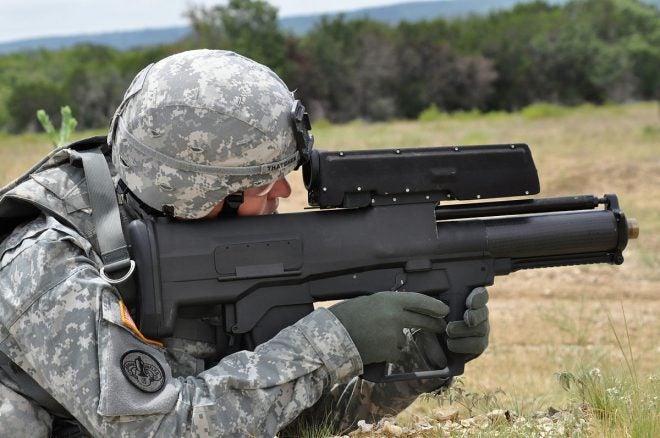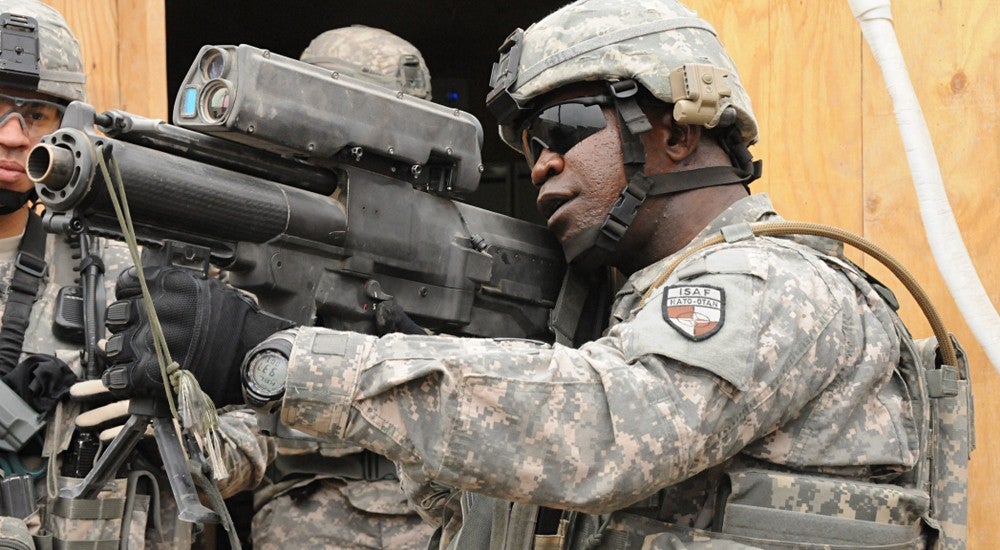The US Army is seeking to increase the lethality offered by its 40mm grenade launchers. For decades the M203 has been the US Army’s go-to under barrel grenade launcher, only recently has the M320 from Heckler & Koch surpassed it. Now the U.S. Army’s Army Contracting Command have launched a search for a new Precision Grenadier System or PGS.
The US Army’s Request for Information (RFI) was issued on behalf of Product Manager Individual Weapons to “identify potential sources for a Precision Grenadier System (PGS) or any technologies towards this objective.” The RFI explains that the PGS is envisaged to be:
a man portable integrated weapon system that enables precision engagements to destroy personnel targets in defilade and in the open with increased lethality and precision compared to the legacy M203/M320 grenade launchers. The PGS provides overmatch to comparable threat grenade launchers in near peer formations in future operating environments (jungle, urban, woodland, subterranean, desert, day/night). The PGS is envisioned to consist of a weapon, a fire control, and a suite of ammunition which enables the user to engage targets in defilade/cover, hovering UAS targets, conduct door breaching, engage close combat targets, and light armored targets.
From this description, it appears that they are seeking a standalone weapon, not an under barrel launcher. It seems they are seeking a weapon which can fulfil some of the aims of the old XM29 Objective Individual Combat Weapon (OICW) program that finally saw the emergence of the stand-alone XM25 Counter Defilade Target Engagement System which after a lengthy gestation period and some field trials in Afghanistan was finally abandoned in July 2018.
The RFI goes on to lay out some basic requirements. The PGS must have the ability to achieve a high probability of incapacitation given a shot within 30 seconds (from the minimum engagement distance to 500 meters) against unprotected personnel targets in defilade/cover or stationary exposed target. It must also be capable of providing incapacitating effects to a range of 1000m.
The grenade must reach its target in less than 5 seconds at ranges out to 500m. The weapon itself must be ambidextrous, not exceed 34 inches and not weigh more than 14.5lbs. The weapon must be semi-automatic in action, suggesting a magazine fed weapon. The weapon will have “the ability to acquire targets with a high Probability of Recognition Given a Detection out to a range of 500 meters in clear air during day and night time conditions and a high Probability of Recognition Given a Detection out to a range of at least 300 meters in obscurants.” It must be able to operate unpowered to continue the fight if it loses power and have a variable power optic and a ranging capability. It also describes a Digital Overlay System which is capable of:
providing alpha-numeric display and a dynamic reticle within the fire control field of view out to a range of 1000 meters. System is capable of calculating a dynamic reticle for refined targeting and will update based on variable required to accurately engage targets including (but is not limited to) range to target, atmospheric conditions, weapon orientation, and ballistics of the weapon/ammunition selected. The computation time for the dynamic reticle to be displayed is no more than 1 second.
The Army would also like a family of ammunition capable of a range of uses:
- Counter Defilade Round: Round to precisely and quickly defeat personnel targets in defilade positions.
- Training Round: Non-pyrotechnic round ballistically similar to the counter defilade round to train the PGS capability.
- Armor-Piercing Round: Round capable of a hitting a lightly armored vehicle out to a minimum engagement distance to 500 meters day or night with an armor penetration of between 1.0 to 2.0 inches at 90 degrees rolled homogenous armor.
- Airburst Less-than-Lethal Munition: An airburst less-than-lethal munition capable of delivering effects out to 100 meters covering a five-meter radius.
- Close Quarters Battle Round: Round capable of delivering lethal effects to exposed, personnel targets to 75 meters.
- Counter Unmanned Aerial System (UAS) Round: Round capable of defeating small UAS systems out to 300 meters.
- Breaching Munition: Munition capable of breaching solid wood doors 1.5 inches thick, windows, and gates, at 50 meters.
All in all the PGS program is seeking a highly capable modern weapon system with a range of requirements which will require technology that surpasses that developed for the XM25 CDTE system. The emerging threat of battlefield drone use has also added an extra layer of requirements. Interested companies have until December 3rd to submit their proposals and ideas.
 Your Privacy Choices
Your Privacy Choices

